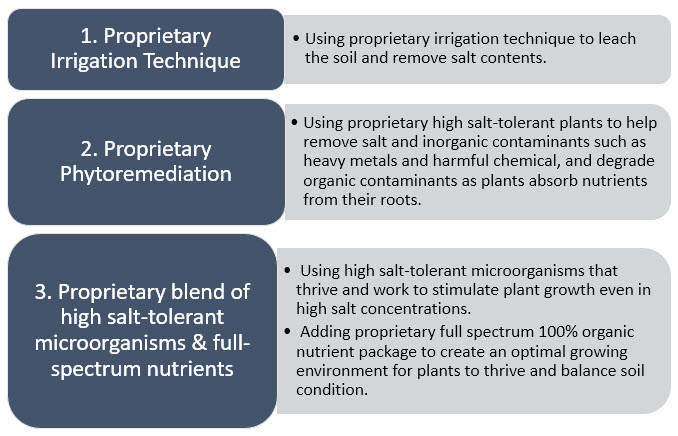SOIL SALINITY MANAGEMENT

Our product is a full spectrum bio-fertilizer and bio stimulant specially formulated by isolating beneficial bacteria – Halomonas, Bacillus and desert root fungus, Piriformospora Indica – that thrive and work to stimulate plant growth even in high salt concentrations. Our proprietary bacteria formula not only thrive in salinity condition but also offer extra benefit by remediating salinity environments; while fully performing other functions under any extreme environment.
This balanced formula also contains essential macro & micronutrients plants need for optimal growth. This formula improves the plant’s metabolic processes and increases its tolerance to physical and biological stresses by balancing the soil’s pH levels and reducing soil salinity. Unlike other fertilizers, it is packed full of amino acids – the basic building blocks of plant proteins. In essence, it also contains macromolecules that chelate and facilitate the transfer of nutrients to the plant. Engineered to break down and increase organic matter within soil, frees trapped carbon and other vital plant nutrients.
HIGH SALT-TOLERANT BENEFICIAL MICROBES
A land that is repeatedly used for farming will experience the salinity rises; the irrigation water has salt in it and when it evaporates or is taken up by the plants, the salt is left behind. This problem is especially prominent on irrigated land, because soluble salts present in the water get deposited in the soil, and accumulate over time. The problem is worsened by drought, which increases water use and speeds up evapotranspiration, leaving more and more salt behind in the soil for crops to grapple with.
Our products formulated with high salt-tolerant beneficial microbes will enable land that are unable to sustain plant life due to high salinity to be farmable again. Our proprietary microorganisms has been experimented and shown to grow plants healthily in soil treated with 1% salt – conditions that would kill or seriously undermine the growth of regular, untreated plants. Those bacteria enable plants, in some way, to withstand the salty conditions of desert soils.
An experiment found that untreated plant grown as a control in these saline soils grew to be small, withered, and pale. By comparison, the inoculated crop grew into noticeably higher and denser plants, with longer shoots and roots – essentially developing into what appeared to be regular, healthy crops, despite the hostile conditions.
How much deeper will water penetrate my soil when I use the product on my fields?
Our product will drastically increase how deep water penetrates the soil. A recent sample from a field that was treated with the product for 10 days showed that water was penetrating almost 12 inches into the soil. While another field under the same conditions, but without the product, only penetrated 5 inches of soil.
How does the product reduce the effects of soil salinity?
When put into the soil the bacteria will start multiplying which breaks down organic matter and transforms it into organic acids. The acids then start to combine with various matter in the soil including salt. This is known as chelating. Chelation is when a coating is formed around matter such as salt or metals. This coating allows plants to absorb more nutrients from it while taking in less salt. As the bacteria continues to multiply and chelate, water starts to penetrate deeper which causes salt to move downward. This chain reaction allows water to reach deeper in the soil while also removing salt from topsoil and moving it deeper into the ground giving your plants access to more nutrients.
Our proprietary salt-tolerant microorganisms form bio-films on plant roots to protect the roots from salinity environment while producing exopolysaccharies (probiotics) which suppress pathogen proliferation (fighting plant diseases) and induce systemic plant resistance.
What are the functions of our salt-tolerant microbes?
Our microbial products contain unparalleled proprietary high salt-tolerant microorganisms. The most notable difference between our line of microbial products and that of other manufacturers is encompassed in the following three words: Bio-diversity, Endospores, and Equilibrium.
We have conducted rigorous lab and field compatibility studies in Africa, Southeast Asia, and the U.S. to ensure the synergy and efficacy of this formula:
Bio-Diversity: Our salt-tolerant bio-diverse microorganisms are critical for promoting nutrient cycling in soil when applied to the root zone or as a foliar treatment.
- By contrast, mono-cultural strains (without diversity) are susceptible to environmental pathogens and more easily succumb to lysing, denaturation of their DNA, and death
- The bio-active potential of these microbial spores (vs. “live” microbes which live and die), ensure a longer duration of nutrient uptake by plants throughout all phases of the growth cycle
Endospores: Our products contain high salt-tolerant bacteria.
- Rationale: Spores (vs. active cells) limit metabolism and catabolism, thereby increasing shelf life and minimizing excessive genetic mutation of bacterial cells, which can lead to mutant cells that do not perform the way they were intended.
- Converting our products into endospores ensures fidelity (long-term activity), significantly reduces genetic mutations and stabilizes the quality of the product.
- By contrast, the quality of viable (“live”/active) cells in a container risk jug expansion or compression due to excess metabolism or CO2production in the container.
- Endospores are absolutely the preferred form due to their preservation, fidelity, quality assurance of performance in the field, and high shelf life.

Equilibrium: After many QA trials, we believe that a heterogeneity of microbes promotes a prolonged duration of soil balance, resulting in season-long composting by the bacteria.
- Biodiversity and redundancy allows for
- Accelerated organic mineralization in the soil
- Nutrient release
- Perimeter protection against pathogens
- Improved soil tilth leading to better air and water channeling
Remediation: The beneficial soil organisms that will degrade heavy metal and harmful chemical, and restore the symbiotic relationships between the soil, the amendments, and the environment. The process begins with replacing the biology that was killed off and create a robust profile teaming with beneficial microbes. Mycorrhizal fungi, nitrogen-fixing bacteria, bacillus megaterium, paenibacilus, azobacter and pseudomonas bacteria are vital strains easily wiped out heavy metal and harmful chemical. They need to be replaced to break down the bonds created by chelation or aggregation. These strains need to be accompanied by supporting bacteria strains that do the heavy lifting to support plant health and vigor. The goal is to provide the strains that reverse the disease cycle, by inoculation at fairly high CFU counts, and replace what has been removed or destroyed.
|
SALT-TOLERANT BENEFICIAL BACTERIA |
|
| Genus Azotobacter | · Aids nitrogen fixation in association with non-leguminous plant roots in the presence of oxygen (which usually inhibits the nitrogen fixing enzymes). By contrast, others do so by consuming all oxygen sources within their immediate surroundings.
· Increases uptake of N3 (atmospheric nitrogen). Historically, microbes were discovered as the original mediator for N3 Produces three enzymes, catalase, peroxidase and superoxide dismutases to neutralize reactive oxygen species. |
| Genus Bacillus | · Nutrient Decomposition: Assists resistance to environmental factors such as heat, desiccation, radiation and chemical attacks, which can persist, in the environment for long periods. The endospore is activated at times of nutritional stress, allowing the organism to persist in the environment until conditions become favorable.
· Enzyme, Plant-Growth Hormones, Soil Structure: Produces enzymes, antibiotics, and small metabolites. It produces a variety of extracellular enzymes that are associated with the cycling of nutrients in nature. · C:N Ratio (Carbon & Nitrogen): Isolates the nitrate reductase enzyme to increase beneficial anaerobic respiration on nitrate. Additionally, oxidizes carbon monoxide aerobically. · Phosphate Solubilization: These microorganisms join by polysaccharides on the cell wall to extract inorganic phosphorus from insoluble compounds. Used as a preventative measure to inoculate plants against pathogens. Also used in the making of penicillin and enzymes. · Lactic Acid Formation: Amends soil with organic materials for rapid microbial growth to significantly increase nutrient uptake. · Prophylactic: Boosts bacterium growth that prevents rhizoctonia and fusarium spores from germinating. Builds high resistance to environmental stresses including UV light exposure, desiccation and the presence of oxidizers. · Bio-pesticide: Functions as a natural insecticide and endotoxin in many insecticides and pesticides. |
| Genus Paenibacillus | · Nitrogen Fixation (conversion), nutrient cycling, soil structure: Capable of fixing (converting) nitrogen into a compound that is readily accessible by plants. The sources of less-accessible nitrogen (N2) are found in soil, plant roots, marine sediments, and the atmosphere.
· Prevents Pathogen Encroachment: Similar to other strains, these bacteria form bio-films on plant roots to produce exopolysaccharides (probiotics) which suppress pathogen proliferation (fights plant diseases) and induce systemic plant resistance. |
| Genus Pseudomonas | · Pathogen Reduction: Produces antimicrobial compound PCA-phenazine-1-carboxylic acid (C13H8N2O2) which prevents Rhizoctonia and Fusarium spores from germinating when applied to seedlings
· Auto-Immune Disease Reduction: Via Aerobic Denitrification and Nitric oxide dis-mutation |
| Genus Streptomyces | · Significant Anti-biotic: Commonly found in soil and deep sea sediments. Demonstrates significant activity against organisms that cause plagues and diseases by producing antibiotics
· Anti-fungal: Strong in-vitro antagonism against various fungal plant pathogens in plate assays by producing extracellular anti-fungal metabolites |
| Genus Trichoderma | · Strong preventative nematicidal (anti-worm) measure: Applied to root zone as an anti-fungal Penicillium which treats Botrylis and Fusarium. |
| MYCORRHIZAE | |
| Genus Glomus | · Supports root extensions |
| Genus Saccharomyces | · A species of yeast involved in secretory pathways of antibodies against diseases |
PROPRIETARY BLEND OF NUTRIENTS & ORGANIC MATTERS
Our products also provide an energy rich blend of bioactive substances works to revitalize and feed the soil-plant complex so the plants thrive. The combined variety of bio stimulant materials are to provide a synergy of benefits including:
- Macronutrients (N-P-K) & micronutrients – derived from organic source and proprietary blended. When crops i harvested, the nutrients follow the crop. Important nutrients are, therefore removed from the soil. Often the soil is not able to replenish all the nutrients by itself, that is where our product supply the nutrients that are lacking; while our microbes work to increase soil nutrient availability by transforming unavailable nutrients into bioavailable forms for plant uptake.
- Essential minerals & vitamins – support plant symbiotic cycle.
- Natural plant hormones – added to increased stress resistance and aid in root development.
- Essential sugar/carbon/protein – supplied in a ready-uptake as fuel for plants vigor.
- Seaweed extracts – for a broad spectrum of micronutrients and aid root development.
- Amino acids – improve the beneficial microflora by strengthening the outer walls, allowing them to withstand harsher conditions. Happier, stronger microbial colonies help produce better nutrient uptake, as well as a more extensive and healthy root system, that can fight diseases and maintain effectiveness in adverse environmental conditions. Amino acids also are amazing chelators. They can be activators or precursors to beneficial growth auxins and phytohormones.
- Humates – for improved soil structure and increased nutrient uptake. The soil needs to be opened up to energize the microbes and amend the soil with humates. Humates come from organic matter that has decomposed as far as possible. Each microscopic humic acid molecule contains dozens of functional molecular groups and around 100 negatively charged sites that can bind with agricultural chemicals.
Our product combines naturally occurring, non-pathogenic bacteria/fungi, organic matters, essential macro, and micronutrients to create an optimal growing environment for plants to thrive and manage stress. At every stage of a plant’s growth cycle, our microbial formulation preserves the soil’s vital nutrients and beneficial insects that are needed to foster growth – helping plants to cope with adverse conditions like drought, frost, high soil salinity, and other environmental factors that can impede their growth and endanger their health. Created in a synergistic consortium, our product is engineered to be broad-spectrum and suitable for virtually all crop types, soil conditions, and climates.
